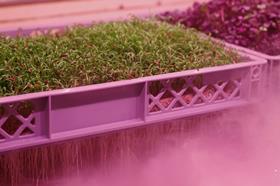
Although growing crops all year around withControlled Environment Agriculture (CEA) has been proposed as a method tolocalise food production and increase resilience against extremeclimate events, the efficiency and limitations of this strategy need to be evaluated for eachlocation.
That is the conclusion of research byLuuk Graamans of WageningenUniversity & Research, a speaker at theupcomingAgri-TechE event onCEA, which takes place on 25 February.
His research shows that integration with urban energy infrastructure can makevertical farms more viable.Graamans’ research around the modelling ofvertical farms shows that these systems are able to achieve higher resourceuse efficiencies, compared to more traditional food production, except when it comes toelectricity.
Vertical farms therefore need to offer additional benefits tooffset this increased energy use, Graamans said. One example his team has investigated is whethervertical farms could also provide heat.
“We investigated if vertical farmscould provide not just food for people living in densely populated areas and alsoheat their homes using waste heat. We found that CEA can contribute tostabilising the increasingly complex energy grid.”
Diversification
This balance between complex factorsboth within the growing environment and wider socio-economic conditions,means that the rapidly growing CEA industry is beginning to diversify withdifferent business models emerging.
Jack Farmer is CSO at vertical producer LettUs Grow, which recently launched its Drop & Growgrowing units, offering a completefarming solution in a shipping container.
He believes everyone in the vertical farming space is going to hit acrossroads.“Vertical farming, with its focuson higher value and higher density crops, is effectively a subset of thebroaderhorticultural sector,” he said.
'All the players in the vertical farming space arefacing a choice – to scale vertically and try to capture as much value in thatspecific space, or to diversify and take theirtechnology expertise broader.”
LettUs Grow is focussed on being theleading technology provider in containerised farming, and its smaller ‘Drop& Grow: 24’ container is mainly focussed on people entering the horticulturalspace.
Opportunities in retail
“This year is looking really exciting,” he said.“Supermarkets are investing to ensure asustainable source of food production inthe UK, which is what CEA provides. We’re also seeing a growth in‘experiential’ food and retail and that’s also where we see our Drop & Growcontainer farm fitting in.”
Kate Hofman, CEO, GrowUpagrees. The company launched the UK’s firstcommercial-scale vertical farm in 2014.
“It will be reallyinteresting to see how the foodservice worldrecovers after lockdown – therough numbers are that supermarket trade was up at least 11 per cent in the last year –so retail still looks like a really good direction to go in.
“If we want to haveanimpact on the food system in the UK and change it for the better, we’recommitted to partnering with those big retailers to help them deliver on theirsustainability and values-driven goals.
“Our focus is very much as a saladgrower that grows a fantastic product that everyone will want to buy. And we’refocussed on bringing down the cost of sustainable food, which means doing itata big enough scale to gain the economies of production that are needed to beable to sell at everyday prices.”
Making the numbers add up
The economics are an important partof the discussion. Recent investment in the sector has come from the MiddleEast, and other locations, where abundant solar power and scarce resourcesaredriving interest in CEA. Graamans’ research has revealed a number of scenarioswhere CEA has a strong business case.
For the UK, CEA should beseen as a continuum from glasshouses to vertical farming, he believes. “Greenhouses canincorporate the technologies from vertical farms to increase climate controland to enhance their performance under specific climates.'
It is this aspect that isgrabbing the attention of conventional fresh produce growers in open field and covered cropproduction.
A blended approach
James Green, director ofagriculture at G’s, thinks combining different growing methods is the way forward. “There’s a balance in all of these systemsbetween energy costs for lighting,energy costs for cooling, costs of nutrientsupply, and then transportation and the supply and demand.At the end of the day, sunshine is prettycheap and it comes up every day.
“I think a blended approach, whereyou’re getting as much benefit as you can from nature but you’re supplementingit and controlling the growth conditions, is what we are aiming for, ratherthan the fully artificially lit ‘vertical farming’.”
Graamans, Farmer and Hofman will join adiscussion with conventional vegetable producers, vertical farmers andtechnology providers at theAgri-TechE event‘Controlled EnvironmentAgriculture isgrowing up’ on 25 February 2021.



